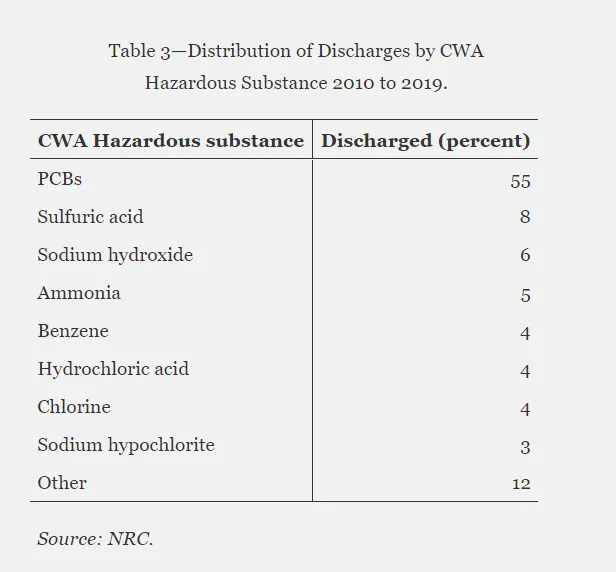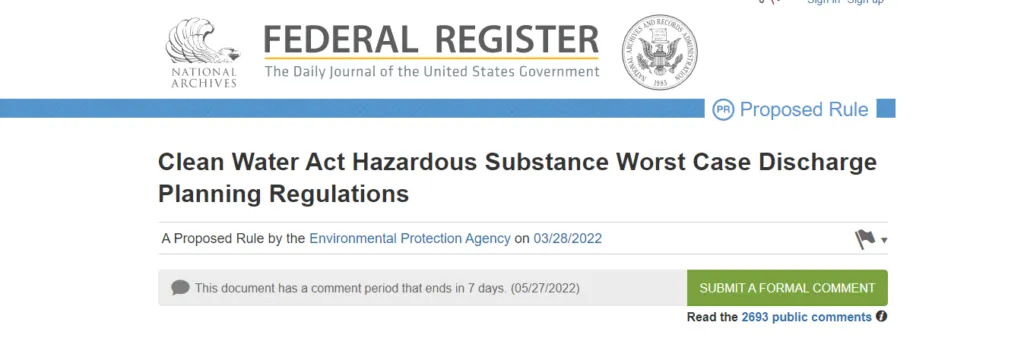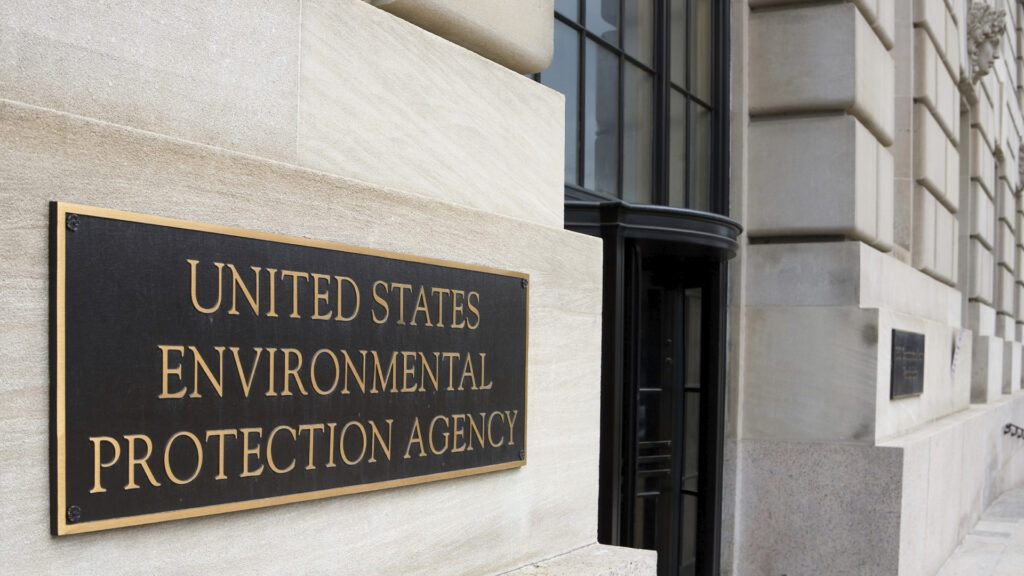You might have missed it among the many other proposed regulations that have come out recently, but EPA recently published a significant, new proposed rule that would require many facilities to develop plans to respond to potential “worst case discharges” of chemicals at their facility. The proposed rule builds upon EPA’s authority established in the Clean Water Act (CWA) and will potentially create new compliance obligations for a large number of facilities across many different industry sectors.
In what follows, we’ll take a look at the CWA proposed rule and its background, and provide some key takeaways to help you prepare.
Background of the CWA Proposed Rule
The CWA, which establishes the basic structure for the EPA to regulate discharges of pollutants into the waters of the United States and regulating quality standards for surface waters, was first enacted in 1972, and amended by the Oil Pollution Act of 1990. Section 311(j)(5) of the CWA established EPA’s authority to issue regulations which require facility operators to prepare and submit plans “for responding, to the maximum extent practicable, to a worst-case discharge, and to a substantial threat of such a discharge, of oil or a hazardous substance (emphasis added).” The full list of chemicals considered to be hazardous substances under the CWA and the associated reportable quantities (RQs) is in Table 117.3. The table below contains the most common CWA-listed hazardous substances from 2010 to 2019, based on National Response Center (NRC) data.

EPA had addressed the first part of its CWA-given authority toward preventing discharges of “oil or a hazardous substance,” but not the second part. The first part happened in 1994, when EPA issued regulations for worst case discharges of oil under 40 CFR part 112, which comprise the basis of Spill Prevention Countermeasure and Control (SPCC) requirements. Still, that left many facilities that store CWA-listed hazardous substances unaddressed by EPA regulations, at least before this proposed rule.
The impetus for EPA to finally address these facilities came from a lawsuit initiated in March 2019 by the Natural Resources Defense Council, on behalf of the advocacy groups Clean Water Action and the Environmental Justice Health Alliance for Chemical Policy Reform. The suit alleged violations of the CWA 311(j)(5)(A)(i) and the Administrative Procedures Act (APA), and maintained that because EPA had not issued regulations requiring non-transportation-related facilities which could cause “substantial harm” to waterways to plan, prevent, mitigate and respond to worst-case spills of hazardous substances, they had not lived up to their responsibilities under the CWA.
The plaintiffs and EPA resolved the litigation by entering into a consent decree on March 12, 2020. The consent decree required EPA to produce and sign a notice of proposed rulemaking within two years (or by March 12, 2022) pertaining to the issuance of the CWA Hazardous Substance Worst Case Discharge Planning Regulations for non-transportation-related onshore facilities. Additionally, per the consent decree, EPA would then have to issue a final rule within an additional two and a half years, or 30 months after publication of the proposed rule. This is an important point to recall later, when we discuss the timetable of what to expect next.
EPA’s Proposed CWA Rule
EPA has issued a new proposed rule called “Clean Water Act Hazardous Substance Worst Case Discharge Planning Regulations.” EPA Administrator Michael Regan signed the proposed rule on March 10, and the rule was published in the Federal Register on March 28, 2022. The signing and publication of the proposed rule satisfy the requirements of the March 12, 2020 consent decree.

The proposed rule would require facilities that could reasonably be expected to cause substantial harm to the environment, based on their locations and chemical storage, to prepare and submit CWA-listed hazardous substance Facility Response Plans (FRP) for worst-case discharges.
Applicability of Proposed CWA Rule
According to EPA’s proposed rule, applicability is based on the following criteria:
- Threshold quantity. The first step in assessing applicability is to determine whether a facility meets or exceeds the container capacity for a CWA-listed hazardous substance onsite at or above a threshold quantity. The proposed rule defines the threshold amount as 10,000 times the RQ for each hazardous substance. The RQs range from one to 5,000 pounds, and are listed in the federal regulation at 40 CFR §117.3. The storage capacity is defined as “the total aggregate container capacity for each CWA hazardous substance present at all locations within the entire facility at any one time.” The proposed rule defines a “container” as “any device or portable device in which a CWA hazardous substance is processed, stored, used, transported, treated, disposed of, or otherwise handled.”
- Location. If the facility manager determines that a CWA-listed chemical stored at the site exceeds the applicable threshold, they must then determine whether the facility is within one-half mile to navigable water or a conveyance to navigable water. It’s a good idea to remember that EPA’s definition of “navigable water” is famously broad. As a rule of thumb, if there’s any body of water within 0.5 miles of your facility, you’ll most likely be subject to the proposed requirements if you meet the threshold applicability described above.
- Substantial harm. If facility meets the above two conditions, the owner or operator next determines whether the facility meets any of the four substantial harm criteria, which are:
- The ability to adversely impact a public water system;
- the ability to cause injury to fish, wildlife, and sensitive environments (FWSE);
- the ability to cause injury to public receptors; and/or
- having had a reportable discharge of a CWA hazardous substance within the last five years
EPA has provided an applicability flowchart in Figure 1 within the Federal Register notice for the proposed rule, which is reproduced below.

It should be noted that according to the proposed rule, an EPA Regional Administrator can also require a facility manager to develop CWA hazardous substance FRPs based on consideration of site-specific factors, regardless of whether the facility meets the criteria described above.
Requirements for Facilities Subject to EPA’s Proposed Rule
What information needs to be included in the FRP? According to the proposed rule, CWA hazardous substance FRP components will include:
- facility information, including the facility name; latitude and longitude; street address (including city, state, and zip code; telephone number, and information regarding the facility’s location described in a manner that would aid reviewers and responders in locating the facility;
- owner or operator information, including preferred contact method;
- hazard evaluation, to ensure that in the event of a worst-case discharge, owners or operators will have pre-identified areas in which adverse impacts to human health and the environment could occur;
- reportable discharge history, for any discharges of CWA-listed hazardous substances above the reportable quantity (RQ);
- response personnel and equipment, including information about the type of equipment at the facility, its location, response times, and testing requirements;
- evidence of contracts or other approved means to ensure the availability of personnel and equipment;
- notification lists, including the identity and contact information of individuals or organizations to be notified in the event of a discharge;
- discharge information, including records of past discharges, the CWA hazardous substance name and quantity discharged, the possible areas and receptors affected and potential routes of transport, distance(s) to nearby waterways and conveyances, data on the characteristics of the CWA hazardous substance and other hazardous substances in proximity, and any other information that may be helpful to responders and the public;
- personnel roles and responsibilities, including the identification and description of responsibilities and the activities that personnel have been trained in and are qualified to conduct in the event of a worst-case discharge;
- response equipment information, including information about the type of equipment at the facility, its location, response times, and testing requirements;
- facility-wide evacuation plan, to evacuate parts of the facility at a high risk of exposure in the event of a discharge;
- a description of discharge detection systems used;
- response actions to mitigate the discharge;
- disposal plans, such as how and where the facility intends to recover, reuse, decontaminate, treat, and/or dispose of materials after a discharge has taken place, and plans for temporary storage of recovered material;
- a description of containment measures for potential discharges, such as drainage systems and spill response equipment such as booms and weirs;
- training and exercise procedures, which may involve existing training for other applicable regulations such as OSHA HAZWOPER requirements in 29 CFR 1910.120;
- self-inspections (see additional details below); and
- coordination activities with local emergency responders.
You can find a full discussion of the proposed requirements in each of the above areas within the proposed rule, but let’s park on self-inspection requirements for a moment, because those will play a central part in a facility’s procedures to prevent a chemical release.
The proposed rule states that a facility self-inspection program needs to include a checklist of things to inspect, and a method of recording each inspection, the date it occurred, and its findings. The proposed rule would also require facility managers to maintain inspection records for 5 years. The proposal states that EPA will be using the public comments to solicit stakeholder feedback on alternative self-inspection and documentation methods. But it’s safe to assume that once EPA’s eventual final rule appears, it will still have self-inspection requirements.
Facility managers subject to the requirements described above would need to complete and submit FRPs for their site(s) to EPA within 12 months of the effective date of the final rule – a timetable we won’t fully understand, of course, until EPA actually publishes a final rule. Facility managers would then need to review and update their plan every five years, or within 60 days of a change at or outside the facility that impacts the potential to cause substantial harm to the environment.
It should be noted that this proposed rule applies to onshore facilities (meaning any facilities situated on unsubmerged land within the United States), per the terms of the 2020 consent decree. EPA is using the proposed rule to solicit comments and supporting data on whether they should also address offshore facilities, other than vessels.
What’s Next For EPA’s Proposed CWA Rule?
While the Federal Register notice indicates that EPA will be accepting public comments on the proposed rule until May 27, 2022, their summary page for the rulemaking states that they’ll be accepting comments until July 26, 2022.
After that, EPA will need to sort through all of the feedback and determine how to account for it during the process of developing a final rule. As of this writing, there are 2,693 public comments, so the process will take a while, but remember, EPA doesn’t have an infinite amount of time. To comply with the terms of the 2020 consent decree, EPA will need to issue a final rulemaking within 30 months of publication of the proposed rule, which would put the deadline in September 2024.
Key Takeaways on EPA’s Proposed CWA Rule
As mentioned, we should assume that EPA will be issuing a final rulemaking within the next 30 months. Managers of affected establishments would need to be prepared.
Here are some high-level takeaways:
It starts with chemical management. A big part of determining if the proposed rule applies to your facility depends on knowing the identities and storage quantities of chemicals in your inventory, so you can see if any CWA-listed chemicals exceed the applicability threshold, and determine “worst case” release scenarios. Look into ways to make your safety data sheet (SDS) library and your chemical hazard information more accessible.
Risk management takes center stage. Facility managers subject to the proposed requirements would need to conduct hazard assessments for the CWA-listed chemicals in their inventory, identifying potential harm from releases and the controls needed to reduce risks. In other words, you need better visibility of risk pathways – the connection between potential causes to an unplanned event, and then the connections between the event and its potential consequences. You also need effective ways to select and implement controls to reduce the potential for a release (preventive controls), to reduce the severity of impact (mitigative controls) or identify when a release has occurred (detective controls).
Inspections will be more important than ever. If your facility is subject to these proposed requirements and needs to implement an FRP, one of the most important required elements will be self-inspections. You’ll need an easy way to develop and deploy site-specific inspection checklists, and to be able to access inspection records to confirm completion or status of findings.
You’ll need visibility of your discharges. Remember, the proposed rule acts upon EPA’s authority under the CWA, and is primarily focused on preventing discharges of hazardous chemicals to water. EPA is proposing that your FRP would need to include records of past discharges, including the chemical involved and the quantity released. Modern environmental compliance software can help by recording and analyzing sample data from all of your discharge points, performing complex calculations about quantities of contaminants, and keeping all of your discharge data accessible in one place.
Sharpen your waste management practices. According to EPA’s proposal, your FRP would need to describe how you’ll be managing and disposing wastes generated from discharges and cleanups. That means you’ll need better visibility of your waste profiles and manifests, so there’s no ambiguity about what you’re doing and whether you’re in compliance with applicable waste regulations.
We’ll share more information about the proposed CWA rule as developments unfold. Don’t forget to follow us on LinkedIn to make sure you stay in the loop!
Let VelocityEHS Help!
Our Safety solution gives you the insights into your chemical inventory you need, with ability to easily access SDSs and associated chemical hazard information. You’ll also improve your emergency response plans with access to exposure support for chemicals 24/7 via a hotline, and you’ll be able to develop and deploy site-specific checklists for your chemical storage locations.
Using our Operational Risk solution, you’ll be able to conduct hazard assessments for your chemicals, and readily map out risk pathways and their associated preventive, mitigative and detective controls.
Finally, the Environmental Compliance capability within our ESG solution can help you better track your water quality compliance and have information about your discharges, including the quantity (load) and concentration of CWA-listed contaminants, in one place.
As always, please feel free to contact us anytime to learn more about how we can help you become safer and more sustainable.
